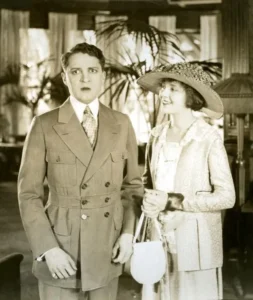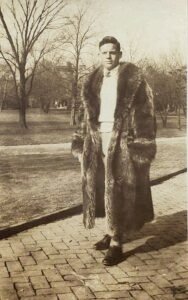As I reflect on my years studying fashion design, I’m continually drawn back to one of the most influential eras in men’s fashion: the Roaring Twenties. My teacher JAMES FRANKLIN often tells us that this decade was not merely a time of change; it was a symphony of style, rebellion, and cultural evolution. He used to call this era, “roaring 20s fashion men“. Our discussion on that topic encouraged me to go deep down and explore more things about fashion in that particular era.
To explore things I made careful research from historical fashion archives and insights from fashion historians to cover everything about fashion in that particular era.
This decade, characterized by prosperity and the aftermath of World War I, witnessed a remarkable transformation in men’s attire. Fashion became a pivotal form of self-expression, reflecting broader societal shifts towards freedom and defiance of conventional norms.
The Birth of Modern Men’s Fashion
The end of World War I brought a sense of relief and a desire for newness among the youth, which led to the transformation in men’s fashion.

Men’s fashion took a leap from formal to a more casual yet sophisticated approach, with an emphasis on comfort and personal expression.
Why Roaring 20s Fashion Men Remains Iconic
Roaring 20s fashion men stands out for its pivotal role in shaping contemporary menswear. This era was the first to popularize the less formal two-piece suit, which has become a staple in the modern wardrobe.
The use of new materials and techniques allowed for lighter fabrics and brighter colors, which introduced a new palette to men’s fashion. Moreover, the Roaring Twenties’ fashion is synonymous with the celebration of individuality and social liberation, themes that are still relevant and admired today.
Key Styles of Roaring 20s Fashion Men
1.Oxford Bag Pants

- Reason for Popularity:
Oxford bag pants were a hit because they were roomier than traditional pants, letting guys move freely. Plus, they made a bold statement against strict dress codes.
- Styling Tip:
Wear Oxford bag pants with a snug shirt and suspenders for a vintage vibe. Try rolling up the cuffs a bit for extra style.
2.Double-Breasted Suit

-
Reason for Popularity:
These suits became super popular because they showed off success and ambition during a time of economic boom. Plus, they looked sharp and put-together.
-
Styling Tip:
Pick a double-breasted suit with thin lines or subtle designs for a classy touch. Don’t forget to add a pocket square to complete the look.
3.Boater Hat

-
Reason for Popularity:
Guys loved these hats because they were both stylish and practical, keeping them cool while adding a touch of charm to any outfit.
- Styling Tip:
Match the boater hat with a light linen suit for a timeless summer look. Tilt it a little to the side for a fun twist.
4.Raccoon Coat

Often worn at football games and large social events, it showcased the wearer’s affluence and alignment with youthful exuberance.
-
Reason for Popularity:
These coats were a big hit because they showed off wealth and extravagance. They were the ultimate status symbol for college guys who wanted to stand out.
-
Styling Tip:
Layer a raccoon coat over a simple sweater and pants for a cozy yet luxurious feel. Keep the rest of your outfit simple to let the coat shine.
5.Casual Pullovers and Knit Vests

-
Reason for Popularity:
Guys loved these because they were comfy yet stylish. They were perfect for hanging out at jazz clubs or speakeasies, showing off personal style without being too formal.
-
Styling Tip:
Layer a knit vest over a crisp white shirt for a smart-casual look. Add some nice trousers and loafers for extra style points.
6.Tuxedos and Tailcoats

-
Reason for Popularity:
Even though the 1920s were all about casual wear, formal outfits like tuxedos and tailcoats were still a hit. They were a symbol of class and elegance, perfect for fancy parties and events.
-
Styling Tip:
Keep it simple with your tuxedo or tailcoat. Just add a classic bow tie and shiny shoes, and you’re good to go.
Comparison
The double-breasted suit was popular for its sophistication and was a favorite among businessmen and politicians, reflecting their status and stability.
In contrast, the Oxford bag pants appealed to the younger generation, symbolizing a break from tradition and aligning with the more relaxed social mores of the time.
Cultural Impact And Legacy
The roaring 20s fashion men did more than just introduce new styles; it changed the way men approached clothing. The era’s styles, from the rebellious Oxford bags to the authoritative double-breasted suit, reflected a society in transition.
They balanced the dual desires for comfort and formality, setting the stage for how modern men dress today.Each piece from the 1920s had its place and popularity, tailored to different social settings and personal tastes.
The double-breasted suit and Oxford bags, for instance, illustrated the decade’s balancing act between established norms and the new, spirited culture that was emerging.
The double-breasted suit was popular for its sophistication and was a favorite among businessmen and politicians, reflecting their status and stability.
In contrast, the Oxford bag pants appealed to the younger generation, symbolizing a break from tradition and aligning with the more relaxed social mores of the time.
Conclusion
My exploration of the 1920s during my fashion degree and research not only highlighted how transformative the decade was for men’s fashion but also helped me appreciate how deeply fashion is intertwined with social and cultural shifts.
The legacy of 1920s men’s fashion continues to influence designers today, reminding us that the styles of the past are not just old trends but historical narratives woven into the very fabric of society.


